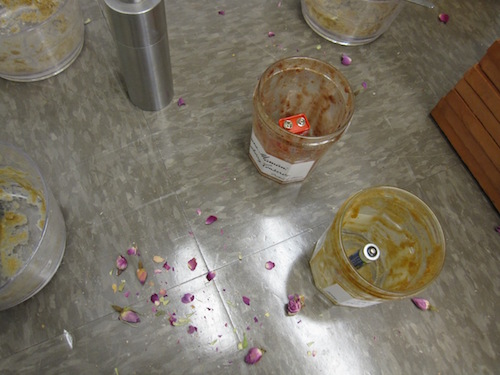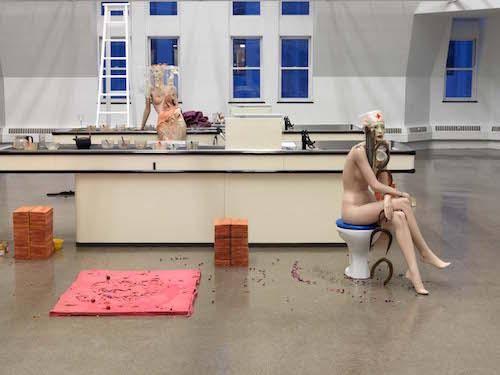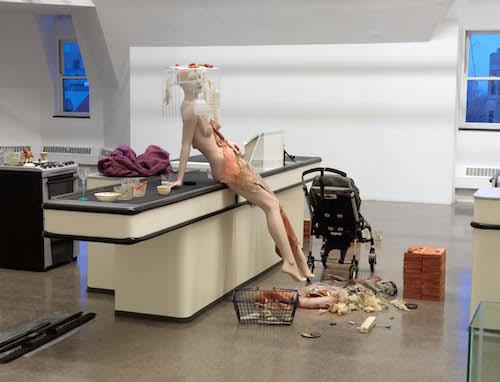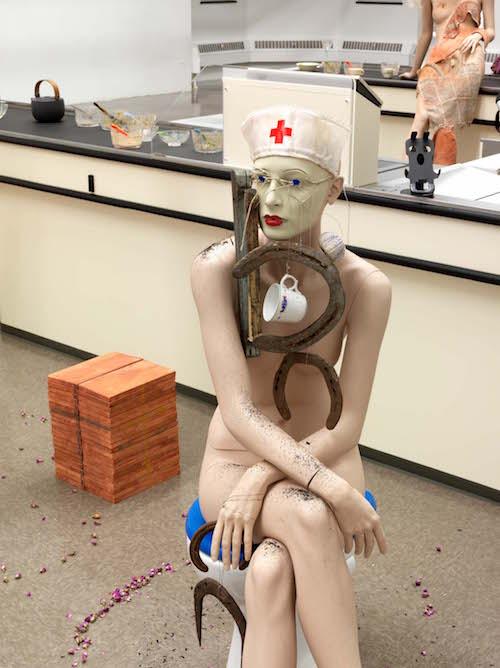Aborted Nurses: A Geopoetics, for Mother’s Day (and the formula babies)

There are two human figures amidst the mayhem in Cathy Wilkes’s I Give You All My Money, a centrifugal 2008 installation reconstructed for various locations over time, which I lived with, or rather worked aside, at The Renaissance Society in Chicago over the course of winter 2012. Two mannequins, to be exact, naked and with unirrupted breasts, dolled up with red, white, & blue Pierrot mask/faces as if cast in some Carnival revival of the 1980s twice removed. One of them lounged in that way that only mannequins can—unbendingly poised, suspended in permanent plantar flexion above contact with ground—upon a checkout counter; the other brooded upon a ductless toilet, her legs and wrists crossed with a dummy decorum to match the cross upon her cap. These figures of arid consumption and defecation made bedfellows of the marketplace and domestic space, and exposed the white gallery—littered with porridge-encrusted jars, dried petals, ashes, half-collected or half-strewn pottery shards and porcelain doll parts, and horizontal finger-paintings realized in the lap—as part of a vast and resolutely dysfunctional digestive system.

Hamza Walker invited me to give a tour of that show, explaining this choice in his introduction to the event by way of Jodie Foster’s exclamation in Contact (“They should’ve sent a poet”); and I came up with what I called a mobile talk that at the time seemed inextricably mired in the very earthly stuff it described—stuff which seemed, in the terms of another, 2005 Wilkes installation, resolutely Non Verbal—but which I haven’t since been able to discursively shake.
Perhaps that’s because Futurism keeps coming up nurses.
But that part of the story may have to wait. Let me take a few steps back.
The artist behind I Give You All My Money was born in Belfast and was trained and lives in Glasgow, a city situated on the River Clyde that became a key hub of trade for the British Empire with the Americas in the eighteenth century, building ships and channeling the movement of sugar, cotton, tobacco, and manufactured goods; it’s now one of Europe’s top financial centers. With this strategic position in global markets as surround, it’s not surprising that the University of Glasgow was one of the epicenters of the Scottish Enlightenment that produced Adam Smith, whose Theory of Moral Sentiments (1759) and Wealth of Nations (1776) theorized the gap-ridden projections of sympathy between persons and the “invisible hand” regulating market cycles. Both aspects of Smith’s work seem to inhere in I Give You All My Money. At the heart of its theater are checkout belts functioning as stalled allegorical rivers Clyde or rivers Nile, nodes—albeit unplugged—of a much vaster circuit of exchange. And twin nurses, albeit of the aborted kind.

In a catalog to her 2008 show at the Milton Keynes gallery, Wilkes writes about the moment in which Jochebed sends her baby Moses to float down the River Nile in a bulrush basket (knowing that otherwise, as a Hebrew boy, he will be drowned in accordance with the Pharoah’s orders). The basket in her installation is the kind you find in your local supermarket. It’s been displaced from the river/conveyer belt, emptied of anything that resembles a baby, or food, for that matter, except perhaps an emptied tube and some wool or discolored cotton—and then redoubled upon the head of its “mother,” who despite being draped with dirty rags remains poised with urbane indifference, as if from a plate-glass poolside diorama. Her head thereby becomes a bird and the basket a cage, the whole ensemble now echoing the mannequin submitted to the 1938 International Surrealism Exhibition by André Masson. The persona here becomes not only commodity but pet, prisoner, citation, and the allegory’s tectonic plates start to shift, basket overturning like the table in Marx’s Capital: “as it emerges as a commodity, it changes into a thing which transcends sensuousness. It not only stands with its feet on the ground, but, in relation to all other commodities, it stands on its head, and evolves out of its wooden brain grotesque ideas….”
On the conveyer belt itself, not food in its pristine packaged state, but a neatly arranged row of bowls with spoons that have been eaten from, crusty with gruel and in need of washing—in need of that sort of work whose laboring hands are no longer so invisible, now that their absence leaves soiled receptacles lingering where the cash register has displaced the sink. It’s labor like that of the mother, the charwoman, the gallery’s custodial staff (and that of the surrounding university) that the artist forces us to apprehend (like Mierle Laderman Ukeles before her): translated back into the terms of the value system we recognize, it’s money. These bowls and the dishes and jars that stipple the gallery, sometimes joining the basket in being flipped upside down, lead us to teeter between implied biological states. On the one hand, satiation. On the other, hunger.
Adrift among husks of comfort and of myth strategically fossilized in the midst of an apparent material chaos, we find ourselves, in entering Wilkes’s tableau, in a forum that confuses the contrast between the classical Greek agora, shopping center of the polis and place of discourse, and the oikos, or home, place of bios, of animals, children, and women. Stroller, fishtank, a stovetop of Bambi and Goldilocks residua seem to situate us resolutely inside the home, but the space is peopled by mannequins and defined by islands equipped for retail transactions that hail from and lead well beyond. The two species of space are resolutely intertwined, and perhaps their reciprocal contamination is what we find so unsettling. They are on display within the same economy, or ecosystem, of waste and entropy, giving the whole installation a gastrointestinal feeling. Terracotta floor tiles are stacked as if for sale while residue of the artist’s uselessly cutting them in half, then cleaning, stains the mannequin and the blanket and rags; the pottery comes as shards, soon to return to the clay condition; the wool isn’t ready for manufacturing, but presented to us in the state between animal and product, shorn and unsifted, still harboring curls. Lying by the white ladder, with its invitation to a mythical and socioeconomic interpretation, rungs have been charred.
Wilkes tells us that years of unemployment and reading (they seem to go together) convinced her there wasn’t a point in imposing a point upon her work. She is instead devoted to Simone Weil’s ideals of attention: of contemplation without thoughts, aperture to things in search of communion with what’s outside, dissolving self-definition. In Weil’s activism, such aperture went hand in hand with hunger strike: an emptiness in the stomach that led to cardiac arrest, self-annihilation.
Self-annihilation is manifest in what Wilkes calls a “softness” that a baby experiences with its mother: babies don’t know where they begin and where they end, are open to and part of someone else. As one grows, that sense of boundarilessness becomes more terrifying—though also potentially ecstatic, as experienced through sex, giving birth, nursing.

The nurse in the midst of all manifests this duality: meant to be sterile, she has been framed in an act of defecation or abortion (a reading that the titles of other pieces, like She’s Pregnant Again (2005) and We are Pro-Choice (2007), enforce). The toilet dispenses the infrastructure of waste to the gallery, though as in various other Wilkes installations, it’s not hooked up to any conduit, so we confront hulls of infrastructure in an inoperative whole.
Boundarilessness can also be one with sociopolitical subjugation, political abjection, as Wilkes’s vacuous dummies show. Horseshoes dangling by wire from the nurse’s head and hands pronounce the chattel-like status of this figure of nourishment and healing. The ornamentation around her eyes, a motif in Wilkes’s installations, functions as a sign of wounding, even martyrdom: a crown of thorns substituted by teacup, scorched ladder chunks, and sea urchin shell to forge a laurel wreath or daisy chain gone awry. The material burden borne by the nurse is made literal in this ponderous, inaudible jangle: instead of having much on her mind, she has much upon her mind.
The nurse’s neighbor or double, Wilkes’s Jochebed of late-late capitalism, has let go of a kid that’s everywhere and nowhere in I Give You All My Money, and is currently disassociated from sensuous social ties; one certainly “knows not where to have her.” The unnamed mother’s sacrifice will nevertheless, in the Book of Exodus (2:1-10), lead to her being appointed as wetnurse until her son is old enough to be adopted by the Pharoah’s daughter and become a hero.
Wilkes articulates her interest in the nurse motif, as in the shop mannequin, in terms of empathy—since to try, in a relationship or in actual nursing, “to feel what someone else feels and to accompany them in their experience of life and in their suffering, to me is related to what I am looking for in language as I apprehend it coming from somewhere outside”; and this invokes not only communion but estrangement, as “it acknowledges in itself the unbridgeable distance between human beings and the vastness of their inner world.” In holding onto objects with which she lives in duration, and rearranging them in a repetition she explains in a leaflet for a 2008 Milton Keynes show with the words “My mother is here,” Wilkes presents us with such a “language”—but it’s a resolutely open text.
And one out of any maternal control. For this distance from which language hails can be regarded as sociopolitical. Smith says that each individual is “led by an invisible hand to promote an end which was no part of his intention”—and as we know from the mothers in developing nations victimized by multinationals’ notorious business in infant formula, and have yet to learn while continuing to purchase plastic bottles of hydration those same multinationals pump from drought-ridden parts of the country, this end is often an insidious one. Wilkes’s nurse perches in abject composure in this postlapsarian circuit of supposedly organic functions, dappled with ash and encircled ritually by dried rosebuds: a bellwether of to-be-mum sacrifice to accumulation in a neoliberal economy, in labors disappeared at every juncture by the whiteness of retail or these gallery walls, a stone’s throw from the displacement-in-progress of the Gothic revival Theological Seminary by the budding Gary Becker Milton Friedman Institute for Research in Economics.
The unwashed emptied jam jars in I Give You All My Money—of that common brand Bonne Maman, their motherly repute reinforced by their being both vessel and sweet food—are signs of this disjunctive connection of everyone with mouths, and mums: void receptacles implanted with battery-nipples. Wilkes states that we need objects in order to commune with others from whom we’re ultimately isolated: “there has to be something between you and somebody else and through that thing you become one…. [Y]ou have to have the stuff…the thing between you and the beyond….” As Frank O’Hara noted in “Personism,” the poem can act as that point of contact, like the telephone. But in a socioecology in which the narrative of production and exploitation is continually short-circuited, we still have work to do in defining and sounding nonamorous plots of exchange, like those of “bertha lee and her lyric ways and her urban plan. up and down / the regular highway and every two-tone station, passing through / to cure, for preservation to unfold it all away,” as the first title poem of Fred Moten’s B Jenkins puts it, dedicated to his mom. I’m interested right now in poetics that, like Wilkes’s mysteriously charged treacly jars of Bonne Maman preserves, not only reconstitute ecologies of care (and exploitation), but confess their material substrates—at least to the extent that those substrates can be found out.
I’ve (re)set this mise-en-scène as prelude to what I’m hoping to write about this month, in posts about the transnational/multinational/translational in poetry: about poetry and/as infrastructure, in both the planetary and the absolute local senses. These concerns dovetail in a word that came up in the first panel at the Buffalo Poetics: (The Next) 25 Years conference last month, where I presented alongside Heriberto Yepez, Mark Wallace, Dee Morris, and Stephen Voyce: geopoetics, in the sense of an ecopoetics that foregrounds the geopolitical landscape. I would like, in however fragmentary and rash a form the blog might offer, to explore the poetic function of what Fred Moten and Stefano Harney have recently described as “pause, recess, vestibular remain, custodial remand, hold, holding in the interest of rub, dap’s reflex and reflection of maternal touch, a maternal ecology of laid hands, of being handled, handed, handed down, nurture’s natural dispersion.” This task is the more urgent in a context of lethal racism and border control that continually strips mothers of their babies—strips them even of the right to mourn them, in an aspect of the serial tragedy that Claudia Rankine tracked in the days following the shooting at Charleston’s Emanuel African Methodist Episcopal Church.
In seminars at the University of Chicago this past week, Moten released the maternal from an essential womanliness, specifying that he was interested in an ecology of care “predicated on the ideal and practicality of ungendering the socialization of the maternal function.” Wilkes, the main breadwinner in a relationship with two children, writes of both her parents in 2011, “I can see them standing there. They’re so forceful, they don’t leave, they never leave. There’s no end to them, how can they ever be repaid…. They have a shop but it has hardly anything in it.” Her work a money for the sacrifice that money can’t buy.
So this one goes out (in its insufficiency) to all the moms. And the non-moms. And the formula babies.
An artist, translator, and teacher, Jennifer Scappettone was born and raised in New York and earned ...
Read Full Biography

